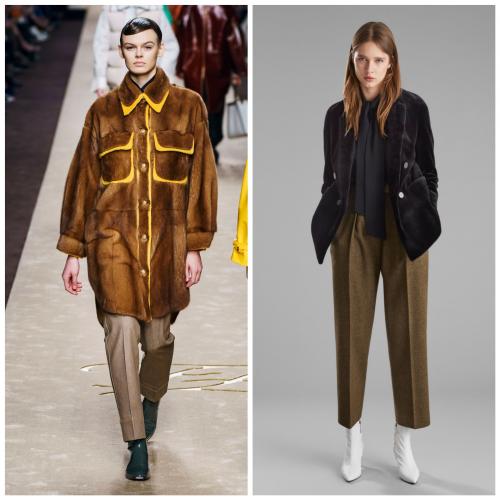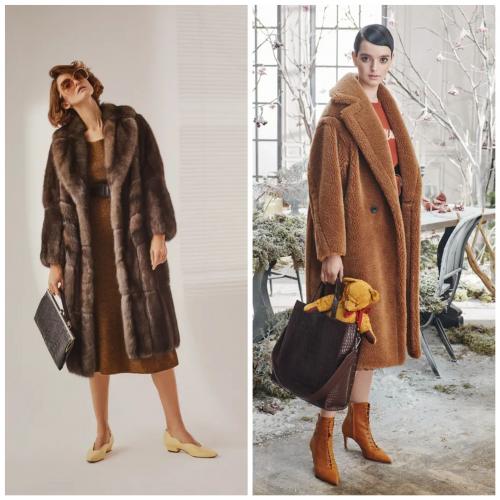What kind of fur do we want to wear this winter – vintage, eco or natural?
We ask ourselves and the fashion world quite honest questions about fur coats and ethics.
Over the past two or three decades, the attitude to natural fur in the fashion world has changed dramatically. From a beloved expensive material and a synonym for the concept of "luxury", natural fur has moved to the status of an unwanted player in the market. One by one, fashion houses began to abandon the use of natural fur in their collections, large multi-brand boutiques do no put mink coats in the storefront, and glossy magazines carefully bypass the "hot" winter theme, flirting with faux fur and other eco-alternatives.
Gucci, Versace, Burberry, Armani, Ralph Lauren, Michael Kors, Vivienne Westwood and one of the last – Prada has already imposed a ban on the use of natural fur. Therefore, you can find fluffy fox fur coat from Gucci or a short sheepskin jacket from Michael Kors only in second-hand stores, vintage stores or so popular recently online stores of secondary designer items.
Due to the very real climate crisis on our planet, which is simply a shame to ignore, such a negative attitude to natural fur and the search for more harmless alternatives is understandable, but we still have a couple of very personal questions about fur.
Is faux fur so environmentally friendly? What to do if you want a product made of natural fur? And is it worth going to extremes when it comes to this type of winter clothing?
Is it so terrible to want a fur coat made of natural fur in the 2019/2020 season?
In your circle of friends, there will certainly be those who defiantly hold on to their mink coats, fox hats and sable vests, claiming that humanity has not yet invented a more wearable, resistant and durable material. And we, residents of the Northern country with prolonged cold, certainly should not get involved in discussions on the topic of "pros" and "cons" natural fur.
In opposition to them always will be a couple of friends, who will recommend down jackets in response to the most severe frosts and condemn the first for cruelty to the environment. However, is there so much hatred for the planet in our desire to have one fur coat made of natural fur instead of two coats and one down jacket from the mass market?
The adherents of natural fur have their own arguments, which are worth listening to, even if you are a desperate vegan in life. For example, the owner of the fashion house Fendi Silvia Venturini Fendi is not going to give up natural fur because of its durability: fur products serve you for years, they do not need to be washed or cleaned as often as normal coats, and when you recycle the fur it's completely decomposes in nature.
Should you be embarrassed to wear real fur, if you already have it in your wardrobe?
No matter how ardent activists protest, the availability of natural fur on sale gives people more freedom of choice when buying. Someone wants to buy a new coat or down jacket with a print or in a fashionable shade every season, and it will be quite enough for a warm Mediterranean winter. And, someone needs one natural fur coat for many years to come. A perfect black color with a light shine and a cozy hood, and all these seasonal inventions on the theme of drawings and styles such a customer does not care too much. Still, the ability to choose is extremely important, since we all have different lifestyles and different needs, which fashion magazines sometimes mistakenly and inhumanly, try to unify.
It is worth understanding that the debate around natural fur is part of an extensive and important discussion on the topic of ecology, where so far the most important evil is the consumption of plastic.
One of the things to understand is that the debate around natural fur is part of an extensive and important discussion on the topic of ecology, where so far the most important evil is the consumption of plastic. In this context, those who buy a new synthetic polyester fur coat every year from a range of democratic brands that have literally flooded the planet with their products should be ashamed.
This was also discussed at the buyer’s forum "The Best Luxury Stores". In Europe and America, people buy natural fur for the glamorous night out, as an element of luxury. In Russia, when the temperature in some parts of the country can fall to minus forty degrees, this is an opportunity not to freeze.
Is it time to run for a sheepskin coat from eco fur for reasons of ethics?
The decision will be yours, but before you rush into things marked eco-friendly and sustainable, let's think about what exactly drives you. The desire not to use any more animal clothing? Then, along with natural fur, it would be nice to refuse natural leather, because it is produced in an equally cruel way.
Or, maybe you have decided that you will start buying wisely and take care of the future of the planet?
The idea is beautiful, and the fashion industry is moving in the same direction with regard to fur.
For example, this year for the first time faux fur was created on a bio-base without the use of polyester, consisting of 100% recycled marine plastic. The only question is how much such a technological innovation will cost an ordinary customer.
Eco fur was also discussed at the buyer’s forum, which we mentioned before. The main theses were about the production of faux fur. First its requires a large quantities of clean water – it is expensive and not at all eco-friendly, contrariwise, many brands try to reduce water consumption during production.
Moreover, in Russia, this trend has not yet taken root, and, as buyers note, there is still very little demand for it, as can be seen from sales.
What to do with an old fur coat or other fur products, which do not fit you anymore?
Definitely you should not throw it away. Natural fur one day, like any vintage clothing, will find its exclusivity and even greater value with the passage of time. Every year, the number of brands that use recycling technologies in the production of clothing is growing, which inspires us to be more aware not only of purchases, but also of the process of recycling clothing.Your fur coats, jackets and vests can be given a second life if you sell or give your products made of natural fur to those who need them more, through online stores or apps for exchanging/selling things.
If the quality of the fur allows, then you can also take your old fur product to the Atelier and make a new one of it to your taste. Even if you do not have any design ideas, the fur can be re-sewed as a lining for your existing coat and make it even warmer.
Fashion trends for winter 2020
Faux fur is exactly like natural fur
Technologists and designers are working hard to create faux fur, which will be indistinguishable from natural fur. You should expect that this trend will be number one from season to season, because the demand for such fur is growing, and it will be possible to please both those who flatly refuse clothing of animal origin, and those who has doubts. In our opinion, the most successful models turned out to be Michael Kors and Moschino — you can't really say from the photo that is faux fur!
Sheepskin in the style of the 1970s
Sheepskin coats usually somehow magically avoid getting into a conflict between adherents and opponents of natural fur. Probably, the thing is that products made of sheepskin are created by both more humane and less humane methods, so the verdict will have to be made for each item separately. On the runways of the autumn-winter 2019 collections, we have marked that the sheepskin clearly refers to the era of the 1970s in both length and cut.
Fur coats made of feathers
Sewn on the fabric feathers resemble weightless fluffy fur, although their method of production animal defenders would certainly question. However, Saint Laurent and Valentino have not yet abandoned the use of natural fur, but, obviously, they are already beginning to look for no less esthetically attractive alternatives to it.
Natural fur in a new form
What would you do with natural fur when everything seems to have been redone? This question is certainly asked by designers who still continue to work with animal fur. How about putting this luxury material on clothes that aren't usually made from fur? For example, a double-breasted suit jacket like Yves Salomon, or an elongated shirt like Fendi.



